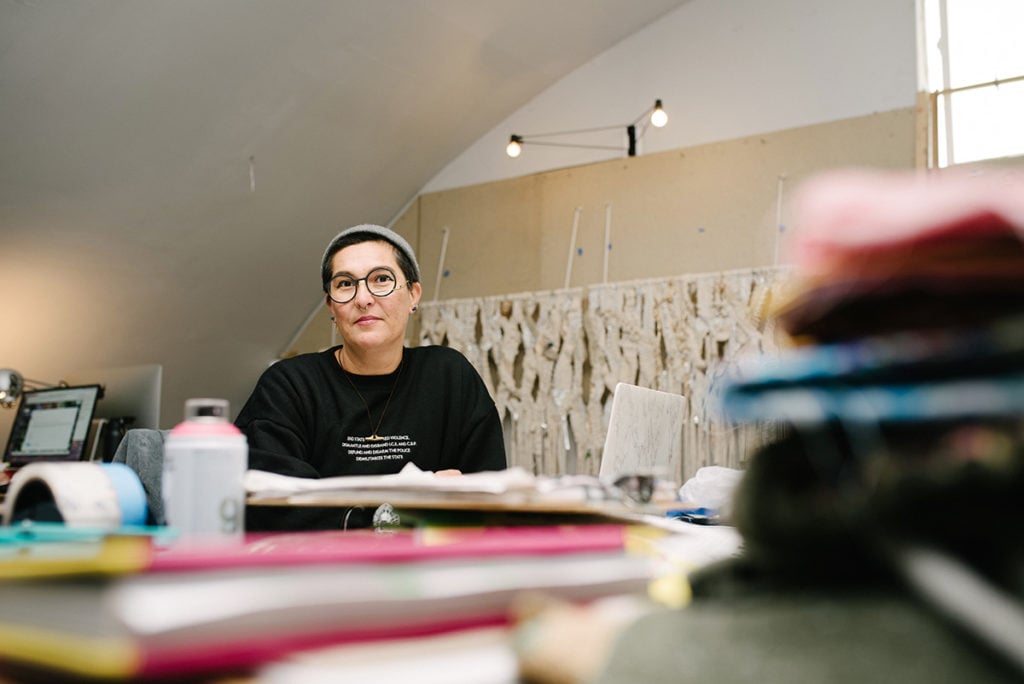 Artists have long addressed our country’s immigration policies in their art, especially the debate over the U.S.-Mexico border. Tanya Aguiñiga has not only created art along that border, but crossed it countless times herself.
Artists have long addressed our country’s immigration policies in their art, especially the debate over the U.S.-Mexico border. Tanya Aguiñiga has not only created art along that border, but crossed it countless times herself.
Aguiñiga, 41, was born in San Diego and raised in Tijuana. Her parents couldn’t afford a babysitter when she was young, so every day for 14 years Aguiñiga left home at 3:30 a.m. to commute to school in San Diego, where her grandmother lived.
“I couldn’t be friends with anybody because they’d know I lived in Mexico and I’d be kicked out of public school because I didn’t live in the district,” recalls Aguiñiga, speaking to the Weekly from her Elysian Park studio. “I couldn’t get close to anybody. It was an unstable childhood.”
Though she was a U.S. citizen, seeing the perilous journey migrants took crossing the San Ysidro Port of Entry — the busiest land border in the country — left a profound impression on Aguiñiga. “In the ’80s and ’90s, there were thousands of people jumping the fence,” she says. “Men were risking their lives daily to live in America. We’d see people get run over. It was such a deadly process to get to the other side.”
Aguiñiga became interested in art while at community college, later earning her MFA at the Rhode Island School of Design. She began her career designing furniture and other functional art, which she felt was, “something people can relate to.” She recently exhibited at the Smithsonian American Art Museum, has just been announced as a COLA Artist Fellow for 2020, and in February will be the subject of a solo show at the Armory Center for the Arts in Pasadena.
During her formative years, she became a community volunteer for artist collective Border Art Workshop. After studying with Mayan weavers and doing some “soul searching” throughout Mexico, Aguiñiga focused on working with textiles, using cotton, canvas, rope, felt and human hair to make sculpture and other large-scale work with her studio team.
“I learned to reconnect with my hands and decolonize my process of working,” says Aguiñiga. “We don’t work with actual looms. We do everything by hand. You can never make a mistake. There’s no right or wrong.”
The duality of having lived in one country while going to school in another, and Trump’s campaign rhetoric about the border, motivated Aguiñiga in 2016 to launch her biggest project, AMBOS (Art Made Between Opposite Sides). Aguiñiga and her team have traveled to 17 border towns from California to Texas, asking commuters in cars and on foot, taxi drivers, vendors, and anyone who congregates at the border to tie two strings — representing the U.S. and Mexico — into a knot attached to a postcard, and then answer the question: “What are your thoughts when you cross this border?”
The knots are inspired by quipu, an ancient organizational system used by the Incas. To date, AMBOS has collected nearly 10,000, which they’ve incorporated into floor-to-ceiling columns. “We want respect (because we are humans just like them),” is just one of the responses.
“It’s an emotional survey of what the entirety of the U.S.-Mexico border is like,” says Aguiñiga. “I want to increase people’s understanding and empathy. We have a symbiotic relationship with these border communities. We depend on each other. It isn’t a black-and-white situation, and you can’t close the door.”

Tanya Aguiniga
Advertising disclosure: We may receive compensation for some of the links in our stories. Thank you for supporting LA Weekly and our advertisers.

